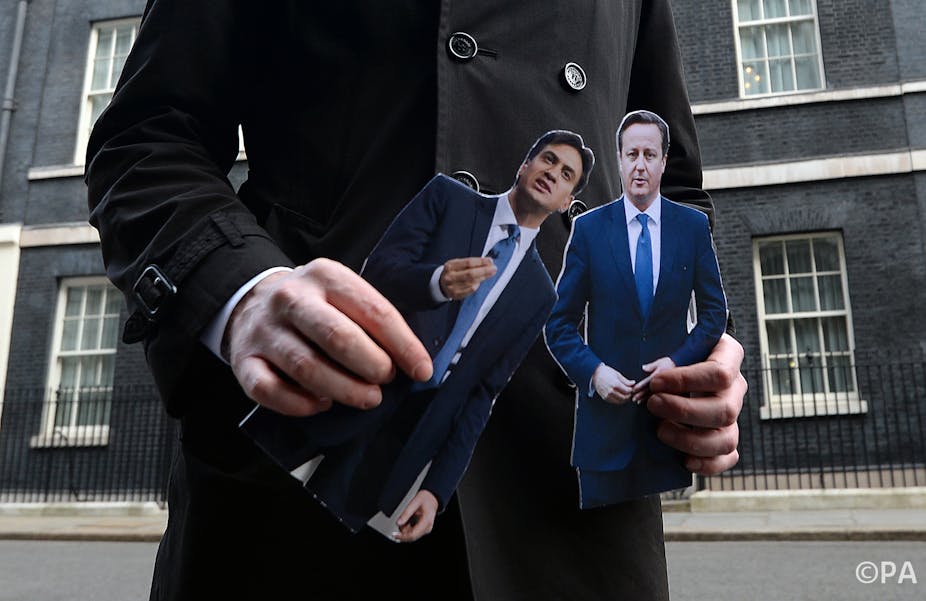With parliament closed, the election campaign is now in full swing and it looks increasingly unlikely that either will win outright. A recent meeting of election forecasters concluded that the UK is heading for what is known as a confidence and supply government. And history tells us that these are incredibly difficult to run.
The chart shows the percentage of the electorate won by various parties in all 18 British general elections since 1945. It highlights the enormous changes that have taken place in the party system over these years and, in particular, how the two major parties have declined.

In 1950 – the first peacetime election after World War II – Labour and the Conservatives won 90% of the vote.
In 2010 these two parties won just 65% of the vote. This partially because of a long-term decline in the number of people turning out to vote but also because the two big parties started to lose support to their rivals.
It is easy to forget how much government in Britain relies on strong political parties. A party or coalition needs a working majority based on a total of about 340 seats in the House of Commons in order to govern effectively. If such a majority can’t be constructed, legislative gridlock is likely to follow. That makes for a weak and ineffective government.
The UK is very different from other countries in this respect. In France or the US, for example, the independently elected president can keep the executive going even if the legislature is paralysed or ineffective.
A lesson from the winter of discontent
There have been minority governments in Britain in the past. The most notable were the ill-fated Labour government of 1929 and, more recently, James Callaghan’s Labour government, which lasted from 1976 to 1979.

This government was not a success. It had to go cap-in-hand to the International Monetary Fund for a stand-by credit in September 1976 when it faced a balance of payments crisis.
Callaghan relied on an informal agreement with the Liberals, the so-called “Lib-Lab pact”, to keep going but his government was ultimately defeated in 1979 after a period of intense industrial strife. Talks on pay restraint between the government and trade unions broke down, resulting in the winter of discontent – a massive wave of strikes which discredited the government and delivered an election victory to Margaret Thatcher.
What happened in 1979 is important because it looks like no viable single party or coalition will emerge from this election.
A conference of forecasters
At a conference of election forecasters which took place at the London School of Economics recently, 12 different forecasting teams made predictions about the number of seats likely to be won by the different parties in the election.
They used a wide variety of different methodologies, including modelling trends in the polls, looking at the effects of the economy on voting, asking the electorate who they think will win, using local government by-election results and even examining Twitter feeds. A consensus emerged that no party was going to win an overall majority. It was also agreed that it will be very difficult to construct a stable coalition government.
The average seat predictions from the forecasting teams were that Labour would win 283 seats, the Conservatives 279, the Liberal Democrats 23, UKIP 3, the Scottish National Party 41, Plaid Cymru 3 and the Green Party 1.
On these figures, neither a Conservative-Liberal Democrat nor a Labour-Liberal Democrat coalition would produce a majority. SNP leader Nicola Sturgeon has ruled out cooperation with the Conservatives and Ed Miliband has rejected a formal agreement with the SNP, so it looks like a Labour-Liberal Democrat-SNP confidence-and-supply administration will emerge after the election.
This means that the Liberal Democrats and the SNP would agree to support a minority Labour government if a no confidence vote were to be called in the House of Commons in an attempt to topple it. The two smaller parties would also pledge to support Labour’s budget proposals.
In exchange, both the Liberal Democrats and the SNP will want some of their own ideas to be taken on board. Each will also have a veto over major government proposals. On top of that, the Liberal Democrats may want seats in the cabinet.
A delicate balance
If this comes to pass, holding it all together will be even more of a challenge for the 2015 Labour government than it was for Callaghan in the 1970s.
David Cameron cannot survive another election defeat and would have to resign the Conservative Party leadership. This would spark a bruising leadership campaign and that would probably give Labour a short-term boost. But the Conservative line of attack would be that the new government is profligate and making too many concessions to the Scots.
A minority government of this type will undoubtedly spook financial markets in the short run since they will be nervous about the uncertainty generated by a government with no overall majority.
On the bright side, such an arrangement does provide an opportunity to ditch the austerity policies that are now widely discredited – particularly in Europe. The Conservatives are increasingly abandoning these policies in practice, if not in theory. Cameron’s recent pledge to invest £4.5bn in infrastructure around the port of Felixstowe is an example of this.
Ed Miliband recently claimed that, despite his critics, he is tough enough to become prime minister. But he is going to have to be more than tough. He will need to be as cunning as Machiavelli to make this work.

